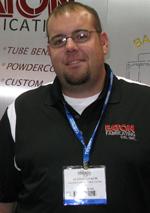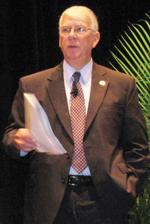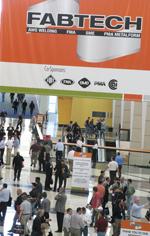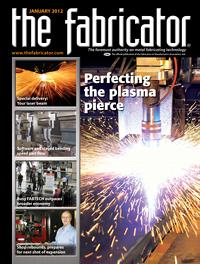Senior Editor
- FMA
- The Fabricator
- FABTECH
- Canadian Metalworking
Categories
- Additive Manufacturing
- Aluminum Welding
- Arc Welding
- Assembly and Joining
- Automation and Robotics
- Bending and Forming
- Consumables
- Cutting and Weld Prep
- Electric Vehicles
- En Español
- Finishing
- Hydroforming
- Laser Cutting
- Laser Welding
- Machining
- Manufacturing Software
- Materials Handling
- Metals/Materials
- Oxyfuel Cutting
- Plasma Cutting
- Power Tools
- Punching and Other Holemaking
- Roll Forming
- Safety
- Sawing
- Shearing
- Shop Management
- Testing and Measuring
- Tube and Pipe Fabrication
- Tube and Pipe Production
- Waterjet Cutting
Industry Directory
Webcasts
Podcasts
FAB 40
Advertise
Subscribe
Account Login
Search
Industry flocks to FABTECH
Busy tradeshow belies broader economy
- By Tim Heston
- January 6, 2012
- Article
- Shop Management
In mid-November Larry Hegel stood in a crowd, not with Occupy Chicago—part of the Occupy Wall Street movement—gathered near the University of Chicago, but several miles away at McCormick Place. Hegel was one of the tens of thousands who attended FABTECH® 2011, a tradeshow that has become the industry’s largest this side of the Atlantic. The factory service support technician said business at his employer, SRS Crisafulli, was charging ahead and topping sales records. Its 30 skilled workers build made-to-order dredging and flood-control equipment.
“This is one of the best years we’ve ever had,” Hegel said.
There’s only one problem: The Glendive, Mont., company isn’t far from an epicenter of economic prosperity, western North Dakota, where an oil boom has left companies desperate for workers. As Hegel explained, some fast-food chains are paying burger flippers close to $20 an hour just to keep them onboard.
The Occupy Chicago protest and one of the busiest FABTECHs ever exemplify a dichotomy that has befuddled government policymakers and industry leaders alike. Millions remain unemployed, yet a growing manufacturing industry still struggles to find people with the necessary skills.
Some exhibitors reported large machines being purchased right off the floor. Attendees said their capital spending budgets remain robust, and many reported double-digit sales growth numbers. And yet at this writing, many economists expect the overall U.S. economy in 2011 to grow a measly 1.8 percent.
Tradeshows rarely paint a complete industry picture. Many attendees obviously have money to spend and enough business to justify it. But the fact so many flocked to FABTECH—35,457 between Nov. 14 and 17—has some significance. Machine tool suppliers also have rebounded from one of the most severe downturns in that sector’s history; they bought more than a half million square feet of exhibit space. The show also now has several co-sponsors: the Fabricators & Manufacturers Association Intl., American Welding Society, Society of Manufacturing Engineers, Precision Metalforming Association, and the Chemical Coaters Association Intl. Together they represent a larger piece of the metal manufacturing pie: sheet metal cutting and bending, tube and pipe, structural fabrication, welding and surfacing, tool and die, stamping, and finishing. All this perhaps make the event a better economic bellwether.
Chris Kuehl, economic analyst for FMA, perhaps said it best during the event’s economic forecast breakfast. “The business community has moved on.” Despite hearing news of mounting government debts and political wrangling, he said, manufacturing managers have new orders, and they need machines to fulfill them.
Building on Success
Jay Mischke of Litchfield, Minn., has certainly moved on from the recession. The director of manufacturing at Custom Products of Litchfield saw sales grow by more than 20 percent each year for the past two years. He mentioned a problem that shows just how far contract metal fabrication has bounced back since 2009: Instead of chasing work, the fabricator now can choose customers carefully. “One major challenge is sorting through [prospects] for the ones who have good potential, and not spending our design efforts on customers who end up not giving us much manufacturing business.”
Mischke’s success story wasn’t alone among attendees’. Thomas Shelow, vice president of Superior Joining Technologies, a welding and cutting contractor in Machesney Park, Ill., takes on extremely high-end, difficult work. Sectors such as commercial aviation, including business jets, have kept the company very busy. “We’re looking at about 25 percent growth over the previous year,” Shelow said, adding that the 19-person shop has been growing at that pace for five years running.
At the other end of the corporate spectrum was attendee Donald Schoenbachler, senior tooling engineer at Babcock & Wilcox’s nuclear operations group in Mount Vernon, Ind. “We’ve got a steady backlog right now, and it’s been steady for the past several years, so we’re looking good for now.”

“We’ve had no layoffs, and we’re booming right now. ” —Lloyd Roach Jr., Eaton Fabricating Co. Inc., Grafton, Ohio
“We’ve grown about 20 percent in the past year,” said Nathan McMasters, president of Diversified Metal Products, an Idaho Falls, Idaho, contract manufacturer specializing in heavy fabrication for the transportation and nuclear industries. “And we just got another deal done last week for even more work.”
Trudianne Wawak and her husband William almost didn’t come to the show, though not because of a lack of work. The two founded Direct Waterjet Inc., a Union, Ill., waterjet shop. “Business has been great,” she said. “We almost thought we wouldn’t be able to come, because we’ve been too busy.”
Keeping Parts Busy
At one morning conference session on lean manufacturing, Rob McCann made a good point. The DeKalb, Ill.-based business development specialist at the Illinois Manufacturing Extension Center (IMEC) recalled how plant managers often call his organization (which receives funding from NIST) to increase efficiencies. They feel that their myriad problems stem from those unplanned downtimes. “So many call on us to help them out with their equipment,” McCann said, adding that this thinking comes from that traditional manufacturing mindset: If machines and people are busy, all is well. But busy machines and people actually don’t make money. Completed parts do.
“You want the product to be busy,” he said. “That’s how you make money.”
For show attendees—the savvy survivors of the recession—it’s not just about getting more machine uptime. It’s about reducing a part’s manufacturing time. To that end, machine, tooling, and other suppliers offered products to make shop floor technicians more productive.
Solid-state cutting lasers, including fiber and disk varieties, gained a significant show presence. But the laser technology itself wasn’t the only element that mattered. These modern machines offer extraordinarily high cutting speeds on thin sheet, but fabricators may not realize the full benefits of that speed if the drive system doesn’t accelerate fast enough. If a fast-cutting laser without good acceleration cuts numerous small parts on the nest, the laser head itself may spend much of its time speeding between cuts, then accelerate only partway during the cut before completing the profile and moving to the next part. This is why machine tool exhibitors highlighted not just cutting speed, but also how fast such lasers can finish a complicated nest of parts.
For bending, new press brakes were exhibited that offer controls with displays showing 3-D models of job setups, as well as specific bend sequences for complicated parts. Some now have lighted displays just above the punch tool clamp, showing technicians not only where to place specific tools, but also which tools to use during the bend cycle, as well as backgauge locations.
So much at FABTECH really was about making things simpler and giving the operator all the information needed to complete the job. This concept extended to welding, with some exhibitors touting screens located adjacent to welding cells that show a 3-D model of the part, the exact weld sequence, weld geometries, heat treats, and more. You could call them welding procedure specifications on steroids.
Changing Minds of a Generation
When asked about challenges, attendees responded with what has become a mantra of metal fabrication: finding skilled labor. Even a roundtable keynote presentation, initially focused on the broader economy, quickly changed course to this hot-button issue.
The problem isn’t simple. One welding instructor in the keynote audience said that during the recession only 30 percent of his students could find jobs. Now he can’t teach enough of them for local industry. After hearing this, Holden Lewis, managing director at BB&T Capital Markets, Equity Research in Richmond, Va., asked a poignant question: “We had a downturn where a lot of manufacturing jobs melted away. They didn’t come back. Policy also seems to be more in favor of capital goods investment than labor investment. The manufacturing sector has been pretty volatile in how it treats its labor. Are companies engaging long-term with their labor force to create a kind of stability that may have been lacking in the past, and may be working against the type of employment you’re looking for now?”

“We need to change the minds of an entire generation.” —Rep. Don Manzullo, R-Ill., commenting on how to bring more skilled workers into manufacturing
Panel members responded by saying that U.S. manufacturers must continue to invest heavily in capital equipment, including automation. Nevertheless, America also needs a skilled workforce to design, build, and manage that automation. Panelist David Lazzeri, president of DuPont Powder Coatings America, also said how loyalty has played a role, both of companies and employees. He added that DuPont has significant employee loyalty; many, himself included, have served the company for decades. Still, he conceded that the problem has pervaded industry for years.
“Over the past five to 10 years, [loyalty] has changed in American industry, and it goes both ways. The young labor force now wants to be mobile. They want to move from place to place. Likewise, the manufacturers have in many ways ‘variablized’ their workforce. There are a lot more contractors and temporary workers. It’s a vicious circle. The one who finds the magic potion on how to reinstall that loyalty is the one who will win, because ultimately people win the day. I’m confident, though, that in the next year or two, demand will create a lot more value for employees, and that may change the cycle.”
Even though manufacturing seems to be driving economic growth, those on Capitol Hill seem to be woefully uninformed about what industry needs. That’s according to Rep. Don Manzullo, R-Ill., who gave the event’s first keynote.
He attributed this in part to the view that America has “moved on” from manufacturing. Factory workers of previous generations sent their children to college to give them a better opportunity in life, so they wouldn’t have to endure a career of assembly-line monotony. That mindset and image of manufacturing has remained, he said, even though the sector has transformed entirely.
Manzullo recalled one regional business council meeting in Illinois in which several community leaders wanted to attract not manufacturing but “technology-related industries” to the local area. Manzullo said nothing, but wanted to say, “Don’t you know they’re the same thing?”
On stage at FABTECH, Manzullo paused, shook his head, and added a coda. “We need to change the minds of an entire generation.”
About the Author

Tim Heston
2135 Point Blvd
Elgin, IL 60123
815-381-1314
Tim Heston, The Fabricator's senior editor, has covered the metal fabrication industry since 1998, starting his career at the American Welding Society's Welding Journal. Since then he has covered the full range of metal fabrication processes, from stamping, bending, and cutting to grinding and polishing. He joined The Fabricator's staff in October 2007.
Related Companies
subscribe now

The Fabricator is North America's leading magazine for the metal forming and fabricating industry. The magazine delivers the news, technical articles, and case histories that enable fabricators to do their jobs more efficiently. The Fabricator has served the industry since 1970.
start your free subscription- Stay connected from anywhere

Easily access valuable industry resources now with full access to the digital edition of The Fabricator.

Easily access valuable industry resources now with full access to the digital edition of The Welder.

Easily access valuable industry resources now with full access to the digital edition of The Tube and Pipe Journal.
- Podcasting
- Podcast:
- The Fabricator Podcast
- Published:
- 04/16/2024
- Running Time:
- 63:29
In this episode of The Fabricator Podcast, Caleb Chamberlain, co-founder and CEO of OSH Cut, discusses his company’s...
- Trending Articles
AI, machine learning, and the future of metal fabrication

Employee ownership: The best way to ensure engagement

Steel industry reacts to Nucor’s new weekly published HRC price

How to set a press brake backgauge manually

Capturing, recording equipment inspection data for FMEA

- Industry Events
16th Annual Safety Conference
- April 30 - May 1, 2024
- Elgin,
Pipe and Tube Conference
- May 21 - 22, 2024
- Omaha, NE
World-Class Roll Forming Workshop
- June 5 - 6, 2024
- Louisville, KY
Advanced Laser Application Workshop
- June 25 - 27, 2024
- Novi, MI



























